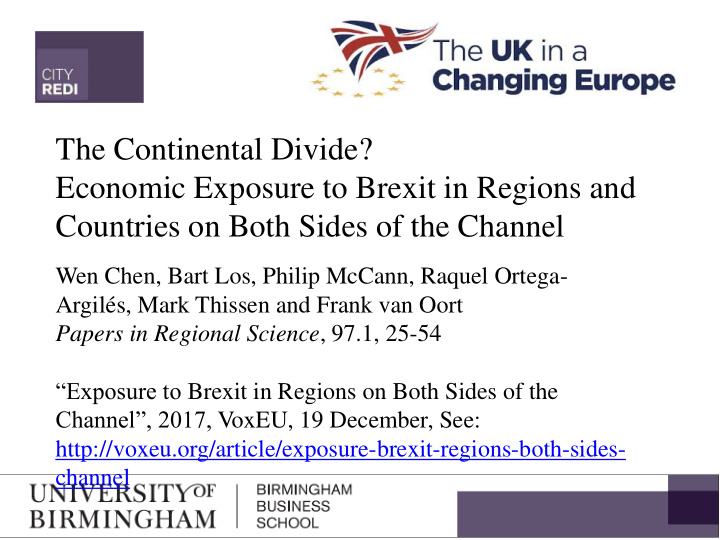



The Continental Divide? Economic Exposure to Brexit in Regions and Countries on Both Sides of the Channel Wen Chen, Bart Los, Philip McCann, Raquel Ortega- Argilés, Mark Thissen and Frank van Oort Papers in Regional Science , 97.1, 25-54 “Exposure to Brexit in Regions on Both Sides of the Channel”, 2017, VoxEU, 19 December, See: http://voxeu.org/article/exposure-brexit-regions-both-sides- channel
How? • Simple measures of gross exports and imports tell us very little about the potential impacts of Brexit on a nation or region, because both the back-and-forth trade in raw materials, parts and components and business services (often within the boundaries of multinational enterprises) typical of global value- chains obscures the links between local value- added and trade (Baldwin, 2016).
Data construction Two types of sources: • The World Input-Output tables of the WIOD 2013 release containing 40 countries (accounting for about 85% of world GDP, including all EU27) plus a composite ‘super - country’ labelled 'Rest of the World' are represented (Timmer et al., 2015). • Second type of data, from regional sources : Eurostat’s regional economic accounts, a number of survey-based regional supply and use tables or input-output tables produced in a subset of countries, and estimates of interregional goods and services trade based on freight and airline business passenger statistics (Thissen et al., 2013). The merging of the information contained in these data sources allows us to: • Incorporate regional details regarding production structure and trade at the NUTS2-level for all major EU-countries in global input-output tables for 2000- 2010. • 245 NUTS2 European regions are represented and 14 industries can be identified for all regions and countries.
How? • We develop a measure of regional exposure to Brexit building upon a flourishing strand of literature using global input-output tables to link trade to value-added (Johnson and Noguera, 2012; Timmer et al., 2013; Koopman et al., 2014). • We use a bilateral version of the Domestic Value Added in Exports (DVAiX) indicator proposed by Koopman et al. (2014).
Input-Output Data Scenario: IO-tables allow for No trade flows mapping of trade to crossing the red labor income and line, as long as EU value added countries are involved (trade between e.g. “Regional GDP Norway and UK exposed to Brexit”: regions still “allowed”) Difference between actual GDP and GDP without EU- UK trade
Research Question “ Which shares of regional Labor Income and regional GDP are at risk as a consequence of future Brexit-related trade barriers ?” (which is not identical to: “Which shares of regional LI and GDP will be lost as a consequence of Brexit?”) How big are the required structural and economic adjustments?
Brexit Exposure Risk • For UK regions: • direct trade linkages (export, import, re-export, re-import) • indirect trade linkages via other UK regions • third country demand mediated via EU value-chains • For EU regions: • direct trade linkages (export, import, re-export, re-import) • indirect trade linkages via other EU regions • third country demand mediated via UK value-chains • Exclude UK-EU and EU-UK demand linkages mediated via third countries
Regional Shares of Local GDP Regional Shares of Local GDP Exposed to Brexit Exposed to Brexit (Excluding the UK)
Map 2. Regional Shares of Local Labour Income Exposed to Brexit Share of Regional Labour Income Share of Regional Labour Income exposed to Brexit exposed to Brexit (UK regions omitted)
National Brexit Exposure Risk • UK regions →10% -17% of regional GDP • Irish regions → 10% of regional GDP • German regions → 4.5% -6.4% of regional GDP • Dutch regions → 3.5% -5% of regional GDP • Belgian regions → 2.8% -4% of regional GDP • French regions → 1.8% -2.7% of regional GDP • Italian, Spanish, Greek → < 1% of GDP • UK Brexit risk exposure = 12.2% of UK GDP • EU Brexit risk exposure = 2.64% of EU GDP • UK Brexit exposure risk is 4.6 times higher than the EU
Sectoral Brexit Exposure Risk City-REDI Policy Briefing Series, December 2017 “An Assessment of Brexit Risks for 54 Industries: Most Services Industries are also Exposed” Bart Los, Wen Chen, Philip McCann and Raquel Ortega-Argilés https://blog.bham.ac.uk/cityredi/wp- content/uploads/sites/15/2017/12/City-REDI-Briefing- Template_Sectoral-Analysis-2.pdf
UK Sectoral Risk Exposure
UK Sectoral Risk Exposure In the UK as a whole, more than 2.5 million jobs are exposed to the trade effects of Brexit Annually, almost £140 billion pounds of UK economic activity is directly at risk because of Brexit Professional, scientific and technical activities, activities auxiliary to financial services and wholesale trade. Financial services are only exposed to 8% of the sector’s GDP - consistent with the estimates for City job relocation to rest of the EU – and the aggregate effect on the UK economy of their exposure is only 0.33% of UK GDP
UK Sectoral Risk Exposure Many important manufacturing and primary industries are highly exposed to Brexit, but so are many services industries (and not just the financial services industry) These services are not only exported directly to EU countries, but also sell intensively within domestic supply chains to UK manufacturing firms exporting to the EU Workers in the jobs at risk are on average slightly more productive than the average British worker – Brexit is likely to exacerbate the UK’s productivity problems
Brexit Priority Grant: The Impact of Brexit on the UK, Its Regions, Its Cities and Its Sectors , ES/R00126X/1, Project Leader Professor Raquel Ortega-Argilés University of Birmingham City-REDI For information please contact Professor Raquel Ortega-Argilés Chair Regional Economic Development City-Region Economic Development Institute Birmingham Business School R.Ortega-Argiles@bham.ac.uk
Recommend
More recommend